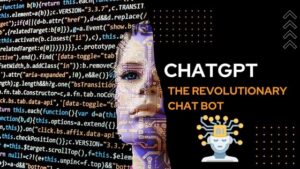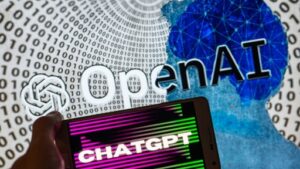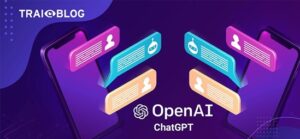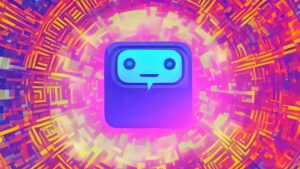WHAT DOES ChatGPT HOLD FOR THE FUTURE?
ChatGPT is the new rage of today and is set to revolutionise the education system, business and marketing. It may even be able to replace humans in the future.

WHAT IS ChatGPT?
Although the AI chatbot ChatGPT has only been in the public’s eye since December, more than one million people are already using it. And with more than 100,000 users logging in for a test run, it’s clear that it has the potential to change the way we communicate. However, there are some pitfalls that ChatGPT must avoid. Specifically, there is a need to train ChatGPT to reject inappropriate requests. For example, bad actors could program it to generate instructions for various illegal activities, such as terrorist attacks.
Hence, it is a significant concern for Google, which is trying to protect its reputation from the possibility of bots that can harm or scam its users. So Google has been guarding the public’s access to ChatGPT very closely.

On the other hand, ChatGPT’s ability to write human-like texts is impressive. It can generate jokes, answer questions, compose music, and write college application essays. But it still has a lot of blind spots. Some commenters have suggested that this technology might lead to the end of white-collar knowledge work. To combat this, OpenAI is trying to address the risks of anthropomorphising the AI systems it builds.
WHY are ChatGPT MAKING WAVES?
The release of ChatGPT by OpenAI, a startup founded by Elon Musk, has ignited social media discussions. The chatbot has already been downloaded more than a million times and is generating significant buzz.The bot combines NLP and machine learning technologies that analyse users’ words and provide relevant responses. It can provide a list of scenarios to choose from and write in a voice like a famous writer. The robot also has a few other tricks up its sleeve. For example, it can explain concepts in simple sentences and generate ideas from scratch. Another thing it does is debug code because the software can identify data patterns and use that information to make predictions and generate responses. As a result, it is capable of delivering tutorials, and it can even provide travel tips. But it is most known for its ability to give users just the correct information. The chatbot can be helpful in practical matters, such as decorating a living room. However, it could be an Achilles heel regarding more abstract issues, such as searching the Internet for something.

CAN ChatGPT REPLACE HUMANS?
There has been a lot of buzz about ChatGPT. Whether or not this artificial intelligence can replace humans is uncertain. However, it does offer a compelling use case. It can provide immediate solutions to complex problems and help to simplify scientific concepts. But some people are concerned that the output is formulaic and lacks nuance and creativity. It depends on the data it has learned from. And because the bot receives training by machine learning, its output is not context-free. For example, it will not answer a question about a bank robbery. Instead, it will answer the question with a factual explanation that may be inaccurate. The system AI can also reject requests that it feels are inappropriate. In some cases, it will even admit its mistakes. But while its output may be helpful for some tasks, it will not be a replacement for humans. Some people are concerned about its capacity to understand the human brain, a crucial factor in how it makes decisions.
ChatGPT vs GOOGLE
There are concerns that Google is on the verge of financial disaster if ChatGPT goes live. In fact, according to Twitter, the chatbot could cost the company over $3 million per month to operate. If it goes live, then ChatGPT will have to compete against Google, which has decades of experience and a massive technology base. As a result, some experts have questioned whether ChatGPT can threaten Google’s search engine. In a thread on Twitter, AI research scientist Margaret Mitchell explains why she believes ChatGPT won’t replace Search anytime soon. Instead, Mitchell argues that it will be an effective tool for providing credible information. However, she warns against the possibility that the chatbot could spread misinformation.
Some have argued that the chatbot is flawed, as it has generated many incorrect answers. Others claim it is still a work in progress. But ChatGPT has made remarkable progress in a short period. Although it’s in beta, ChatGPT has amassed more than a million users in just five days. This is impressive for an artificial intelligence chatbot. It can answer questions on any topic and present information in a conversational style. While it does have the capability to generate toxic material and generate wrong information, it is also capable of presenting information in a manner that can enhance a user’s online experience. For example, the chatbot can write poetry, write song lyrics, and interpret research papers. Still, there’s a lot of room for improvement. ChatGPT needs to learn more linguistic inputs, which costs more money to train. And it must find a quick path to monetisation. Currently, the biggest problem with ChatGPT is that it doesn’t offer a click target which is vital to Google as it is a crucial revenue source. Ad revenue generated 81% of Alphabet’s revenues in 2021. The inclusion of featured snippets would offset the loss of ad revenue. Another issue is that ChatGPT lacks a way to handle current events. Experts are warning against the potential for a bad actor to use the chatbot to amplify ransomware attacks. The use of an artificial intelligence (AI) chatbot in the real world has received a lot of press lately, especially since Alphabet Inc’s (GOOG) stock has been on the skids. Earlier this month, Google announced its first-quarter quarter earnings, showing a revenue growth slowdown. It also underperformed the NASDAQ-100 benchmark.

ChatGPT MAY IMPACT EDUCATION
Whether ChatGPT is the next big thing in education is hard to say. The buzz surrounding AI’s ability to deliver personalised learning experiences has raised the bar on what should be a well-rounded educational experience.

The biggest challenge is implementing the new system in the classroom. Teachers must adjust their thinking when a new AI bot swoops into town. This is particularly true when it comes to grading student work. Some teachers may have to cut out the grade book in favour of a more personalised approach. Likewise, some students might have to take a back seat to a more streamlined process. If you’re a teacher, there’s a good chance you’ve already heard about ChatGPT. It’s been around for more than a year but only made headlines in the last couple of weeks. It could only generate a single answer in the early days, but now it’s been improved to create initial responses each time. Interestingly, it also has a built-in plagiarism checker that can trace a student’s work to the source. There’s no question that it can be a helpful tool, but there are some limitations. For one, it’s not always possible to distinguish between student-generated and machine-generated work. Also, it can’t decide the best way to display the results. To make matters worse, the average rate at which ChatGPT delivers its answers is abysmal. That’s news for any user trying to solve a problem. Ultimately, it’s a decision made by schools and districts. With so much on the line, making the right decision is essential. Thankfully, there are a few ways to solve this problem. One of the first is implementing a new policy on how teachers will use the tool. For example, a teacher will have to decide if they will use it in conjunction with a traditional assignment or use it independently. Alternatively, the teacher can eschew the task and let the AI do the heavy lifting. Of course, this isn’t a long-term solution to the problem, and some IT admins will likely opt to block it outright.

Artificial intelligence (AI) tools have started changing how we impart education. These tools can help students focus on their creativity and can be used to test their skills. However, they also come with significant risks. The ability to use AI technologies responsibly is essential. Chat GPT is one such tool. It is a new kind of chatbot. This bot is programmed to learn from a large volume of text data on the Internet. A student can give the AI a task, and it will provide advice, write essays, or remix the student’s work. ChatGPT is free. However, educators should be cautious about using this tool. While it can be an excellent tool for improving teaching and learning, it can also pose risks. In addition, it may not always generate accurate information. Students may use ChatGPT for cheating. There have been cases where students used the tool to create fake essays. They might then re-publish these as their own. Additionally, students might be tempted to copy and paste ChatGPT responses to write their answers.

ChatGPT MAY IMPACT MARKETING
When a chatbot like ChatGPT starts answering questions, it could be a massive disruption for business marketing. The technology can help marketers create more valuable content from complex answers. It can also be used to enhance workflows and provide better customer service. ChatGPT is a question-and-answer service powered by artificial intelligence. Technology can automate many of the tasks that humans perform. However, it is still in its infancy, without adequate training to do much of anything. ChatGPT works by responding to text prompts with paragraphs. Like Google, it can answer questions on a wide variety of topics. Unlike Google, though, ChatGPT’s answers are uncluttered and natural. In addition, one can use it to help identify common questions, concerns, and interests. It could also be a helpful way to enhance customer experiences, streamline workflows, and improve digital marketing campaigns.
IS ChatGPT A GOOD TOOL TO CREATE CONTENT?
There are many reasons to be sceptical. For one thing, ChatGPT’s name may be a mouthful, but the company has no problem making its name easy to spell. If that’s the case, then using an AI chatbot to write your articles may not be the best option. Not everyone is comfortable writing for a machine, but the technology can be a productivity booster if used correctly. In the same way that a person can write a single article for several hours, a ChatGPT can perform the same function in less than a minute. While the most impressive ChatGPT function may not be the smartest, there are a few clever tricks in its bag. First, the software can spit out an op-ed – and if you’re a writer, that’s pretty darn good. There is currently no filtering mechanism in place to catch inappropriate content. For example, a user puts a twelve-year-old daughter’s essay into a ChatGPT bot. And the bot misstated the character’s parent’s death.
DRAWBACKS OF ChatGPT
ChatGPT is an artificial intelligence chatbot that has taken the Internet by storm. The bot’s ability to respond to text prompts already amassed over a million users in just five days. However, the bot has many problems that could hinder its ability to use for good. One major issue is that the bot isn’t completely transparent. It doesn’t disclose its sources or how it got its information, so it’s possible for people to find information about the bot online that wasn’t initially intended for them.

In addition, the bot tends to provide incorrect answers, which can cause users to wonder whether the bot is speaking for themselves. Users also have concerns about the bot’s ability to write. Although the ChatGPT system uses AI to generate responses, it’s still a very experimental tool. The bot was developed by OpenAI, a research and development company that Elon Musk co-founded. Initially, the bot was trained on a data set finalised in 2021. However, the ChatGPT model is not capable of answering questions that get posted online after 2021.

The chatbot technology known as ChatGPT is one of the most significant technological developments in the last five years. It could change how we interact with the Internet. But it also has its limitations. While ChatGPT is a powerful tool, it does have its flaws. Its responses are not always correct. This technology is not good at making ethical decisions and will often generate unintended responses.
However, some users have found ways around these limitations. They have asked it to write jokes, answer questions, compose music, and even write programs. And the results have been pretty impressive. The reason is that ChatGPT’s responses get based on data fed into it. OpenAI AI has programmed it to reject offensive requests. That means it will not take the bait on obviously racist queries. Also, future releases will close other loopholes. However, the responses can be very different every time. For example, a ChatGPT can create country song lyrics in the heavy metal style or explain scientific concepts to varying difficulty levels. But this is not necessarily a good thing. The answers aren’t necessarily correct, as it depends on the data derived from the Internet. There are many examples of it presenting misinformation as fact.

ChatGPT can answer questions and even write text. It’s possible to use it to find answers to math problems or to answer customer service and online marketing questions. However, some experts warn that it can give false or misleading responses. The AI is based on a language model called GPT-3.5. The model simulates a conversation between a human and a machine. Many large tech companies use this technology to improve their virtual assistants. But as many people are already finding out, it is not always accurate. Even though OpenAI’s ChatGPT gets trained on a vast data set of text from the Internet, it can give wrong answers. And the model itself can admit to mistakes. The problem with AI technology is that it can perpetuate societal and cultural biases. For example, it can lead to a lack of employment in creative industries. So, it’s not surprising that users of this new product are a bit concerned about how it can be misused.
In addition, many have suggested that ChatGPT can pose a threat to writers. While the robot is good at writing humorous responses, it still has problems with accuracy. As with any AI system, it’s essential to know the implications of using a ChatGPT. A low rate of answers is a severe hazard to users, especially when trying to find a solution. The main issue is the information it provides. Most people do not fact-check before they post their answers. To ensure that ChatGPT doesn’t provide misleading information, it should have to be regulated by a human, which could include requiring users to fact-check their responses before posting them. Also, the company should require users to sign up for a ChatGPT account before they can post their questions. The FAQ on the ChatGPT website does not fully address these issues. There is still a debate about who should regulate it.
 Dr K. Jayanth Murali is an retired IPS officer and a Life Coach. He is the author of four books, including the best-selling 42 Mondays. He is passionate about painting, farming, and long distance running . He has run several marathons and has two entries in the Asian book of Records in full and half marathon categories. He lives with his family in Chennai, India. When he is not running, he is either writing or chilling with a book .
Dr K. Jayanth Murali is an retired IPS officer and a Life Coach. He is the author of four books, including the best-selling 42 Mondays. He is passionate about painting, farming, and long distance running . He has run several marathons and has two entries in the Asian book of Records in full and half marathon categories. He lives with his family in Chennai, India. When he is not running, he is either writing or chilling with a book .
